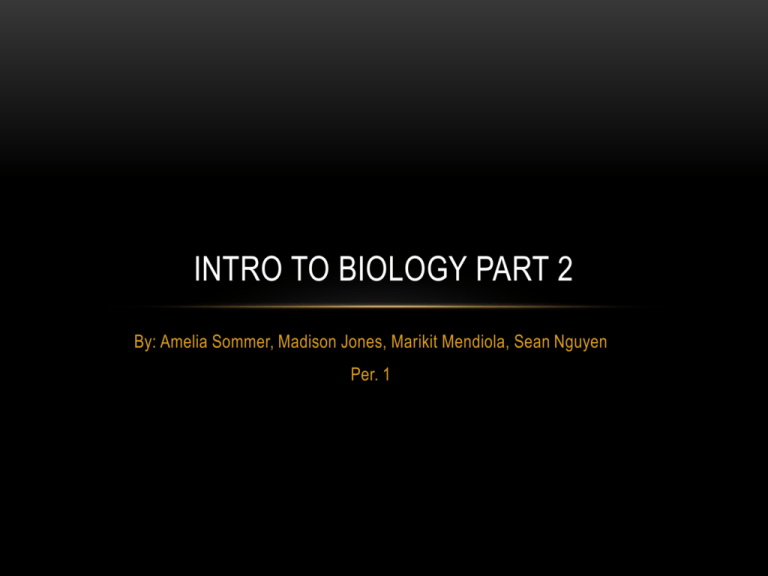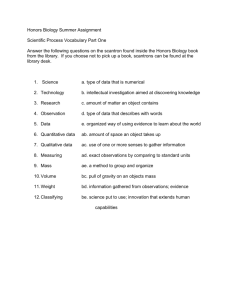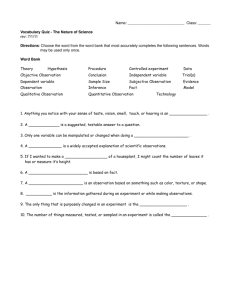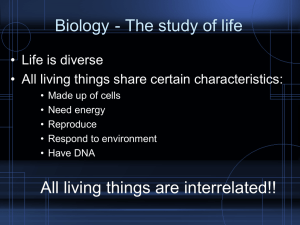Intro to biology part 2
advertisement

INTRO TO BIOLOGY PART 2 By: Amelia Sommer, Madison Jones, Marikit Mendiola, Sean Nguyen Per. 1 SCIENTIFIC METHOD • Hypothesis: a testable statement that can be shown to be true or false by experimenting or observation • Experiment: Experimental Group: receives some kind of treatment or condition. • Independent Variable: Treatment or factor that is changed Control Group: receives no treatment, used to compare. It is important to have a control to compare and validate results. CONT. • Data: a scientist carefully collects and organizes data from the experiment. Data should always be presented in a neat fashion, usually tables. • Analysis: Data can be powerfully displayed as a graph • Conclusion: Based on the data, a scientist then determines whether the hypothesis was supported or refuted LANGUAGE OF SCIENCE LANGUAGE OF SCIENCE • Examples: • Biology • Geology • Microbiology • zoology PROCEDURE WRITING • Write each step out • Make it detailed • Conclusion should be precise and to the point CHAPTER 1 READING GUIDE • Quantitative: numeric data • 20 cats each weighing 20 lbs • Qualitative: descriptive data • All the cats are orange with purple stripes, and are soft CONT. • Controlled variable: factor that is purposely kept the same • Ex. Gravy boiled flask • Manipulated variable (independent): factor that is purposely changed • Flask is either sealed or unsealed • Responding variable (dependent): factor that is being observed, which may change in response to the manipulated variable • Growth of microorganisms CONT. • Observation: use of one or more senses to gather information • Variables: factor in an experiment that can change • Theory: well tested explanation that unifies a broad range of observations CHARACTERISTICS OF LIVING THINGS • Made up of cells • Reproduce • Based on universal genetic code • Grow and develop • Obtain and use materials and energy • Respond to their environment • Maintain a stable internal environment • Taken as a group and changed over time LABELED MICROSCOPE MULTIPLE CHOICE Q’S Review (answers on final slide) QUESTION #1 • What is a hypothesis? • A) treatment or factor that is changed • B) well tested explanation that unifies a broad range of observations • C) testable statement can be shown true or false by experimenting or obersvation • D) use of one or more senses to gather information QUESTION #2 Match the word with the definition: • A) study of cells • 1) Anthropology • B) study of humans • 2) Gymnosperm • C) uncovered seed • 3) Cytology • D) below skin • 4) Hypodermic • (prefix and suffix list on slide #4) QUESTION #3 • Match each with the definition: • A) descriptive data • 1) quantitative • B) study of life • 2) qualitative • C) numeric data • 3) biology • D) nerve pain • 4) neuralgia QUESTION #4 • Which is the definition of an independent variable? • A) factor that is purposely kept the same • B) factor that is purposely changed • C) testable statement that can be true or false • D) factor that is being observed which may change in response to the manipulated variable QUESTION #5 • What does the coarse adjustment knob do? • A) holds the slide in place • B) moves the stage slightly to sharpen image • C) moves the stage up and down for focusing • D) used to support the microscope when carried QUESTION #6 • What is the definition of variable? • A) use of one or more senses to gather information • B) factor in an experiment that can change • C) well tested explanation that unifies a broad range of observations QUESTION #7 • Match each letter with the correct number • 1) diaphragm • 2) objective lense • 3) eye piece • 4) base QUESTION #8 • What does the prefix carn- mean? • A) ten • B) lungs • C) eat • D) meat QUESTION #9 • True or false • Grow and develop is a characteristic of a living thing • Qualitative is numeric data QUESTION #10 • Our elephant died this morning. We predicted it was of starvation. To test this hypothesis, we placed three elephants in the wild without food and left them there. 3 weeks later, we came back and the elephants were all still alive. Is the hypothesis proven correct? • A) yes • B) no ANSWER KEY • 1) Answer is C • 6) Answer is B • 2) Answers: 1-B, 2-C, 3-A, 4-D • 7) Answers: 1-D,2-B,3-A,4-C • 3) answers: 1-C, 2-A, 3-B,4-D • 8) Answer is D • 4) Answer is B • 9) Answers: true, then false • 5) Answer is C • 10) no






